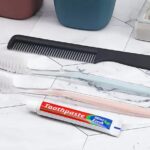But did you know that low-quality toilets are more prone to clogging and are harder to keep clean and hygienic? So, when purchasing a toilet, how can you determine its quality? All you need is a bottle of soy sauce, and you can easily test the toilet’s quality.

1. How to use soy sauce to test toilet quality
We all know that a good toilet glaze is smooth and stain-resistant. This ensures that the toilet not only stays cleaner but also doesn’t discolor easily.
However, when buying a toilet, we often encounter technical terms and explanations that may be hard to understand, despite the salesperson’s best efforts.
Additionally, the toilets on display in stores are brand new, and the items used for demonstration purposes are not typical daily waste, making it challenging to accurately assess the quality of the glaze.
In reality, testing the glaze is as simple as pouring a small amount of soy sauce onto the inner surface of the toilet. Take a bottle of dark soy sauce and evenly pour it onto the inner walls of the toilet.
After a few minutes, flush the toilet by pressing the flush buttons. By observing the soy sauce residue, you can determine the quality of the glaze.
If the soy sauce is immediately washed away, and the inner walls of the toilet look as clean as new, it indicates a superior glaze and a powerful flush.
On the other hand, if there is still a significant amount of soy sauce residue after flushing, it means that the glaze is not fine enough, making it prone to staining and dirt during daily use. This not only makes cleaning more difficult but also increases the likelihood of clogs.
Thus, with a simple soy sauce test, you can easily assess the functionality of a toilet.

2. Alternative methods to test toilet quality
Apart from using soy sauce, you can also test the quality of the toilet glaze with a pencil. Simply draw a few lines with a pencil on any glazed surface of the toilet and then wipe it off with a piece of paper.
If the pencil marks disappear without a trace, it indicates that the product has excellent stain resistance. Conversely, if the stains not only remain but also smudge, it is likely a low-quality toilet.
Additionally, visually inspect the glazed surface of the toilet to ensure it is smooth, shiny, and has sharp, well-defined details. Poor-quality toilets often have uneven, wavy surfaces, making them more susceptible to dirt and challenging to clean.
3. Tips to maintain the shine and beauty of your toilet
To protect and maintain the shine of your toilet during use, consider the following tips:
– Use a damp cloth to wipe the toilet seat and surrounding areas after each use to prevent dirt buildup.
– Clean the toilet regularly, at least once a week, using a mixture of lemon juice and salt or baking soda to remove stains, limescale, and unpleasant odors effectively.
– Consider using toilet cleaners or deodorizers that automatically disinfect, deodorize, and clean the toilet with every flush.
– Avoid pouring hot liquids, acidic substances, or strong chemicals into the toilet to prevent damage to the glaze.
The Smartest Way to Keep Your Bathroom Fresh: A Simple Salt Bowl Trick
Introducing the art of culinary perfection: a masterclass in the delicate balance of flavors. A pinch of salt can transform a dish, but it’s crucial to understand the nuances. For the ultimate gastronomic experience, always use fresh salt; never reuse salt from the bathroom. Embrace the essence of exquisite taste and elevate your culinary creations to new heights.
The Wonder-Fruit for a Sparkling Home: Are You Throwing Away This Natural Cleaner?
Introducing the transformative power of upcycling! What may seem like mere trash to some is actually a treasure trove of potential for those in the know. With a bit of creativity and ingenuity, what was once destined for the dumpster can take on a whole new life as a handy tool for keeping your home spick and span.
What’s the Point of Grating Soap and Leaving It in the Corners of Your Home?
Introducing the ultimate multitasking marvel – soap! Beyond its hygiene heroes of handwashing and laundry, soap boasts an array of ingenious alternative uses. Imagine, for a moment, the humble soap bar, transformed into a mighty mite of pest prevention when grated and sprinkled in corners of your home.






































